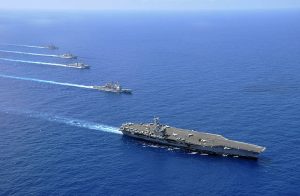Even as the world is facing a clear and present danger in the form of globally mobilized Salafist terrorism and a resurgent and spiteful Russia invading its neighbor, there is a new round of alarmism in Australia about disputes in the South China Sea. With the high profile U.S. freedom of navigation operation behind us, and U.S. Secretary of Defense Ashton Carter’s hawkish tones less audible for now, the issue of strategic imbalance in the South China Sea is gaining currency in Australia.
Concern about a strategic imbalance in the semi-enclosed South China Sea stems in part from the mathematical comparison between Chinese and U.S. forces normally stationed in or near the South China Sea. China’s order of battle in the area far outweighs that of the United States. This should be no surprise, given that China borders the sea area in question and has legitimate claims to millions of square kilometers of maritime resource jurisdiction based on Hainan Island and mainland territory (Guangdong province has 4,000 km of South China Sea coast). In addition, China has claimed several other island groups there since before 1945. In comparison, the United States is not a littoral state and has no claim on territory or resources jurisdiction in the South China Sea.
But the other part of the concern is that China is, in the words of the Australian Strategic Policy Institute (ASPI), “the most motivated actor” and that “other powers either lack the capacity or are reluctant to directly engage in the dispute.” The Institute observed that the international community therefore lacks “options for a solution to strategic competition in the South China Sea because of this asymmetry of motive and capability.”
The concept of strategic balance is a slippery one. It could be understood to mean anything between a comparison of orders of battle (a nearly useless analytical tool) and the much broader, highly political concept of balance of power.
The idea of taking discrete theaters of potential conflict, such as the Taiwan Strait, or, in the Cold War, the Mediterranean Sea, and assessing the military balance (comparative orders of battle) in each theater is not new to military analysis, having figured in the Napoleonic campaigns of two centuries ago. But it is a highly discredited tool.
This is because static comparisons of orders of battle say nothing about the strategic intent or out-of-theater capability that the parties might possess. Comparisons of numbers of in-theater forces cannot convey anything about the military readiness of the units counted and a country’s surge capacity for warfare in the theater, including through potential or existing military alliances. Moreover, in the era of space-based assets and cyber potentials, a Napoleonic approach of counting the forces you can see would be to miss the dominant determinants of warfare in the modern age.
In the light of these considerations, one might easily argue that there is no asymmetry of potential military capability in the South China Sea in China’s favor.
The alleged asymmetry of motive in the South China Sea is equally open to question. Since 1975, the Philippines and Vietnam have (for the most part) refused to back down from their claims even when confronted with Chinese pressure to do so. In fact, the biggest waverer in motive has been the United States. But even it has maintained a position of strength in the region for almost the entire postwar period — some 70 years including, after it was put on notice in 1987 to leave its military bases in the Philippines by 1991. As of 2015, the U.S. position on the South China Sea disputes could not be more stridently against China — at least not while remaining within the bounds of peaceful action.
So where does the strategic imbalance narrative come from?
ASPI director Peter Jennings wrote in a commentary that airfields constructed by China on two islands in the Spratly group provide it “with a capability to control air and sea movements through the region.” This is approaching the fantastical. China could only do so if its intent was not opposed. Jennings attributed to China the calculation that it could “make its territorial gains quickly,” but in fact China has not advanced or changed its territorial claims at all in the past 27 years, possibly the last 82 years. The reefs on which it recently expanded its artificial islands and built its airfields had been claimed by it since at least 1933 and occupied by it since 1987-88.
Jennings also claims that a failure by Australia to undertake freedom of navigation operations near Chinese claimed islands “cedes de facto sovereignty to China of one of the world’s most vital trade transit areas.” I would like to know the connection. I can’t see it.
Anyone arguing that a strategic imbalance exists probably needs to find new evidence to support the case, because nothing in the public record to date, judged by serious analytical tests, reveals an asymmetry of strategic motive or strategic capability between the two opposing sides of the geopolitical positioning now occurring in the South China Sea: China versus “the rest.” If anything, China is outgunned militarily and politically. The Philippines’ action in the Court of Arbitration against China on maritime boundaries in the South China Sea has been a masterful diplomatic victory over China.

































